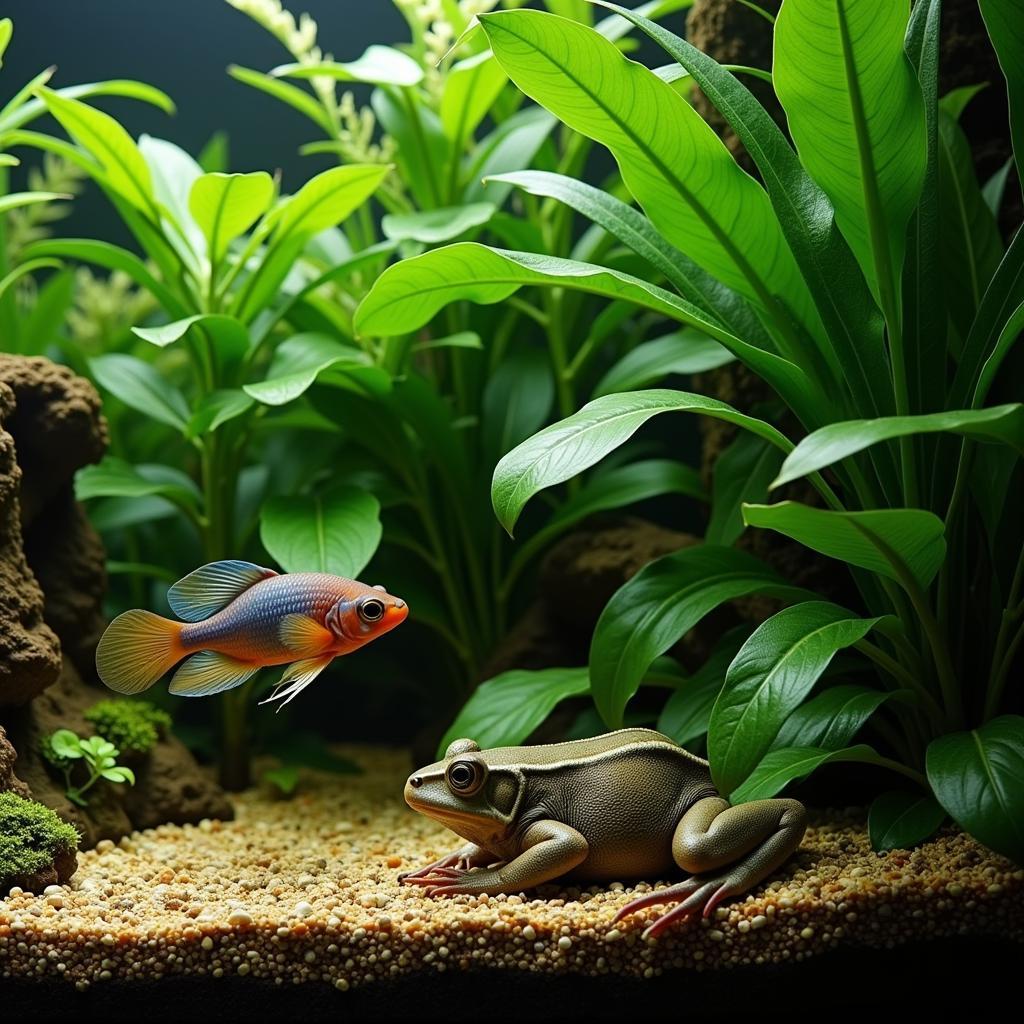African Clawed Frog and Betta Fish: A Peaceful Coexistence?
Keeping African clawed frogs and betta fish together is a question that often arises in the aquarium hobby. While both are captivating aquatic creatures, their compatibility requires careful consideration. This article delves into the specifics of housing these two species together, exploring the potential challenges and offering solutions for a harmonious, if somewhat unlikely, cohabitation.
Understanding the African Clawed Frog
African clawed frogs are fully aquatic amphibians, native to Sub-Saharan Africa. These fascinating creatures are known for their clawed front feet, which they use to tear apart food. They are carnivorous, with a diet primarily consisting of insects, small fish, and crustaceans. In the home aquarium, they require specific conditions to thrive. A spacious tank with plenty of hiding places and a substrate suitable for burrowing is essential. After this introduction to the African clawed frog, we’ll dive into the world of the betta fish.
Getting to Know the Betta Fish
Betta fish, also known as Siamese fighting fish, originate from the shallow rice paddies and slow-moving streams of Southeast Asia. They are renowned for their vibrant colors and flowing fins. Male bettas, in particular, are known for their territorial nature and aggressive behavior towards other males. They are carnivores, requiring a diet rich in protein. While they can tolerate a range of water parameters, they thrive in warm, well-filtered water.
 Betta Fish Showcasing Vibrant Colors and Flowing Fins
Betta Fish Showcasing Vibrant Colors and Flowing Fins
Can African Clawed Frogs and Betta Fish Live Together?
The short answer is: it’s risky. While it’s possible for African clawed frogs and betta fish to cohabitate, it isn’t ideal and requires meticulous planning and monitoring. Several factors contribute to the challenges of keeping these two species together. One significant issue is the difference in their natural habitats and, consequently, their preferred water parameters. Betta fish prefer warmer water than African clawed frogs. Finding a temperature range suitable for both can be tricky.
Potential Problems
- Predation: African clawed frogs are opportunistic feeders and may see a betta fish, particularly a smaller one, as a potential meal. Conversely, a betta might nip at a frog’s sensitive skin or its long, flowing fins.
- Competition for food: Both species are carnivorous and may compete for food resources, leading to stress and potential malnutrition.
- Different water parameters: As mentioned earlier, bettas prefer warmer water than African clawed frogs. Finding a compromise can be challenging and may stress one or both species.
- Territoriality: Betta fish, especially males, are highly territorial and may become aggressive towards the frog, even if it isn’t directly competing for resources.
Creating a (Relatively) Peaceful Environment
If you decide to attempt cohabitation, a large tank is essential. This provides space for both species to establish territories and reduces the likelihood of encounters. Plenty of hiding places, such as plants, caves, and rocks, are crucial for both the frog and the betta. This allows them to retreat and feel secure, minimizing stress and potential aggression.
Careful Monitoring
Constant monitoring is key to successful cohabitation. Observe their interactions closely and look for signs of stress or aggression. If either species appears to be suffering, separate them immediately.
 African Clawed Frog and Betta Fish Sharing a Tank
African Clawed Frog and Betta Fish Sharing a Tank
Conclusion
Housing African clawed frogs and betta fish together requires careful planning, a large tank, and continuous monitoring. While cohabitation is possible, it’s not recommended for beginners. If you’re an experienced aquarist willing to invest the time and effort, it can be done. Remember, the welfare of your aquatic pets should always be the priority. Choosing tank mates wisely ensures a healthy and thriving aquarium environment for all inhabitants.
FAQ
- What size tank is recommended for cohabitation? A minimum of 20 gallons is recommended.
- What are the signs of stress in a betta fish? Clamped fins, loss of color, and lethargy.
- What are the signs of stress in an African clawed frog? Refusal to eat, excessive hiding, and skin discoloration.
- What should I do if the betta fish is attacking the frog? Separate them immediately.
- Can female bettas live with African clawed frogs? While less aggressive than males, female bettas can still pose a risk.
- What is the ideal temperature for a mixed tank? A compromise temperature around 75-78°F might be necessary.
- What kind of food should I feed them? Offer a varied diet of high-quality pellets, frozen foods, and live foods appropriate for each species.
For further assistance, please contact us at Phone Number: +255768904061, Email: kaka.mag@gmail.com or visit us at Mbarali DC Mawindi, Kangaga, Tanzania. We have a 24/7 customer support team.



